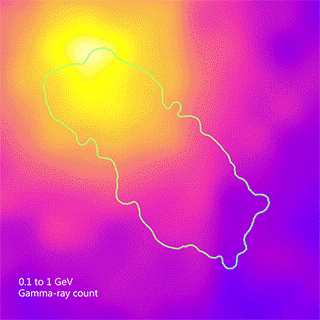We are living in an exciting time, where next-generation instruments and improved methods are leading to discoveries in astronomy, astrophysics, planetary science, and cosmology. As we look farther and in greater detail into the cosmos, some of the most enduring mysteries are finally being answered. Of particular interest are cosmic rays, the tiny particles consisting of protons, atomic nuclei, or stray electrons that have been accelerated to near the speed of light. These particles represent a major hazard for astronauts venturing beyond Earth’s protective magnetic field.
At the same time, cosmic rays regularly interact with our atmosphere (producing “showers” of secondary particles) and may have even played a role in the evolution of life on Earth. Due to the way they carry an electric charge, which scrambles their path as they travel through the Milky Way’s magnetic field, astronomers have been hard-pressed to find where cosmic rays originate. But thanks to a new study that examined 12 years of data from NASA’s Fermi Gamma-ray Space Telescope, scientists have confirmed that the most powerful originate from shock waves caused by supernova remnants.
The research was led by Ke Fang, an assistant professor with the Wisconsin IceCube Particle Astrophysics Center at the University of Wisconsin–Madison. She was joined by researchers from the Naval Research Laboratory, the Kavli Institute for Particle Astrophysics and Cosmology, the SLAC National Accelerator Laboratory, the Catholic University of America, and the Center for Research and Exploration in Space Science and Technology (CRESST) at NASA’s Goddard Space Flight Center. The paper that describes their findings recently appeared in the Physical Review Letters.
Mitigation against cosmic rays is one of the main considerations regarding future missions to the Moon and Mars. Like solar radiation, these high-energy particles pose a risk to astronaut health due to their effect on skin tissue and organs, but also from the “showers” of secondary particles they produce. This occurs when cosmic rays come into contact with our atmosphere, which produces lower-energy particles like neutrons or electrons, most of which are deflected off into space.
In space, however, cosmic rays produce showers after impacting with dense material – such as radiation shielding. Aboard the ISS, the impact of these rays creates showers of secondary particles that pass through the hull and fill the interior with lower-energy radiation. While ISS astronauts can limit their exposure to this radiation by rotating back to Earth, long-duration missions will not have that luxury. For crewed missions to Mars, astronauts will spend up to a year and a half in transit, plus several months on the Martian surface.
For this reason, knowing where cosmic rays come from and the kind of energies they can achieve is essential to developing improved protection and mitigation methods. For years, astronomers have been searching for where the highest-energy cosmic rays come from – those that exceed 1,000 trillion electron volts (PeV). These rays are ten times the energy generated by the Large Hadron Collider, the most powerful particle accelerator in the world, and are almost powerful enough to escape our galaxy.
“Theorists think the highest-energy cosmic ray protons in the Milky Way reach a million billion electron volts (or PeV) energies,” explained Fang in a recent NASA press release. “The precise nature of their sources, which we call PeVatrons, has been difficult to pin down.”

While it is difficult to track cosmic rays back to their origin, scientists have observed how they collide with interstellar gas near supernovae, which produces gamma rays (the highest energy light there is). From this, scientists suggested in a previous study (also based on Fermi data) that a significant fraction of primary cosmic rays originate from supernova explosions. For the sake of their study, Prof. Fang and her colleagues analyzed twelve years of Fermi data on SNR G106.3+2, a comet-shaped supernova remnant located about 2,600 light-years from Earth in the constellation Cepheus.
Using its primary instrument – the Large Area Telescope (LAT) – Fermi detected billion-electron-volt (GeV) gamma rays from within G106.3+2’s extended tail. Similar observations were conducted using the Very Energetic Radiation Imaging Telescope Array System (VERITAS) instrument at the Fred Lawrence Whipple Observatory in southern Arizona, the High-Altitude Water Cherenkov Gamma-Ray Observatory in Mexico, and the Tibet AS-Gamma Experiment in China. These observatories detected even higher-energy gamma rays reaching up to 100 trillion electron volts (TeV).
While cosmic ray particles would initially be trapped by the supernova remnant’s powerful magnetic fields, their path causes them to repeatedly cross the supernova’s shock wave. The particles gain speed and energy with each pass and eventually become too fast for the supernova remnant to hold onto them. At this point, they fly off into interstellar space, where they become incredibly difficult to trace back to their source. Co-author Henrike Fleischhack, a researcher from the Catholic University of America in Washington and NASA’s Goddard Space Flight Center:
“This object has been a source of considerable interest for a while now, but to crown it as a PeVatron, we have to prove it’s accelerating protons. The catch is that electrons accelerated to a few hundred TeV can produce the same emission. Now, with the help of 12 years of Fermi data, we think we’ve made the case that G106.3+2.7 is indeed a PeVatron.”

The supernova remnant is also notable for the pulsar J2229+6114 at its northern end, which astronomers think was born from the same supernova. This pulsar emits gamma rays as it spins, creating a strobing effect (like a lighthouse) that are typically less than 10 GeV in energy. These emissions are only visible during the first half of the pulsar’s rotation and did not present any significant interference for Fermi. Nevertheless, the research team was able to isolate G106.3+2.7’s higher-energy emissions by analyzing gamma rays arriving from the latter part of the cycle.
Their detailed analysis overwhelmingly shows that PeV protons are what was driving the powerful gamma-ray emissions they observed. This research has demonstrated that supernova remnants are the source of the most powerful cosmic rays in the Universe, though some questions remain. While astronomers have identified other potential sources of PeVatrons – including Active Galactic Nuclei (AGNs) – supernova remnants remain at the top of the list. Yet out of about 300 known remnants, only a few have been found to emit gamma rays at these energies.
“So far, G106.3+2.7 is unique, but it may turn out to be the brightest member of a new population of supernova remnants that emit gamma rays reaching TeV energies,” Fang added. “More of them may be revealed through future observations by Fermi and very-high-energy gamma-ray observatories.”
Further Reading: NASA, Physical Review Letters

